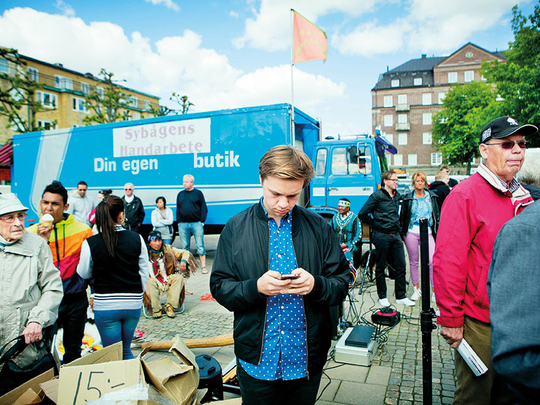
STOCKHOLM: It was a radical experiment in free speech, even for Sweden: Give ordinary and not-so-ordinary people the chance to be, more or less, the official voice of a nation. After seven years of Twitter posts on topics as varied as manga comics, ugly sweaters and the dangers of prescription drugs, Sweden is calling it quits.
Since 2011, control of the Twitter account @sweden has been handed to a different person each week, allowing the curators to tweet about almost anything they please. At the end of September, after 356 curators and more than 200,000 tweets, the experiment will end.
The messages, largely in English, have ranged from didactic to deeply personal, polite to racy. Along the way, @sweden has provoked heads of state, stirred controversy, got laughs, earned 147,000 followers and even drew some imitators.
- Anna Rudels | Swedish Institute
Finland and Ukraine began @peopleoffinland and @Ukraine. The late-night TV host Stephen Colbert even tried to become a curator for @sweden, but not being Swedish, he did not qualify.
The Swedish Institute, a government agency dedicated to promoting the country abroad, and Visit Sweden, a tourism group, created the campaign as a way to show the world Sweden and the spirit of “openness and transparency” in a country that has had an anti-censorship law since 1766.
Two years ago, to commemorate the 250th anniversary of that law, the Swedish Tourist Association created a phone line that people around the world could call to be connected to a random Swede and ask questions.
“The idea of one Swede every week was a way of making it authentic and show the openness of how we try to communicate and do things together with people, with a lot interaction and engagement,” said Anna Rudels, the head of communication and digitalisation at the Swedish Institute, said of the Twitter project.
So with only two weeks left of this beautiful account and your open access to a bonafide Swede (and it for once being slow at work): ask me anything! I’ll answer what I can/feel comfortable with. About myself, me as a swede, really random stuff, etc.
— @sweden / Rebecka (@sweden) September 17, 2018
The curators are chosen by a committee — the youngest was 15, the oldest 81 — and each new one became a mini-celebrity. Many used the opportunity to indulge in their favourite subjects or causes — environmental sustainability, linguistics and food were popular topics — while others just chronicled their lives.
Others aimed for the provocative, or achieved it without trying. The first curator, Jack Werner, gave a frank account of his favourite pastimes, earning him the nickname “the masturbating Swede.”
The biggest headlines, said Rudels, came in the wake of Donald Trump’s “last night in Sweden” remark in February 2017, when he seemed to suggest that something terrible had happened, baffling people in Sweden, where nothing much had happened.
Max Karlsson, who was 22 at the time, took over curatorship two days later. He had planned to tweet about architecture, his friends and life as a paralegal in Stockholm. But “then this came,” he said in an interview.
Karlsson thought about handling the situation with humour. Instead, he ended up using the account as a vehicle for fact-checking, trying to answer a wave of questions about false news, he said.
“Everything I posted during the week was public record and data,” he said. “I’m just a 22-year-old regular guy from the suburbs of Stockholm, but I have access to public data, and I used the internet and information technology to spread these facts around the world.”
Many of the people who responded were from the United States, he said, adding, “I had a lot of great interactions with Trump voters.”
The rules of @sweden are simple: Do not violate Swedish law, do not promote commercial brands and do not present a security threat. Curators are also asked to mind their language, respect other people’s views and refrain from sharing racist, sexist or homophobic sentiments.
The Swedish Institute has deleted only seven tweets, Rudels said — three of them for copyright infringement.
But there have been controversies, and curators have been encouraged to add the hashtag #myownview to threads. At times, curators received hateful comments, particularly when they wrote about feminism or lesbian, gay, bisexual and transgender issues. In 2016, administrators noticed an upswing in angry attacks.
“Earlier, the worry was that the curator would write something that crossed a line,” Emma Randecker, who administered the account, told the Swedish newspaper Dagens Nyheter in October 2016. “But now, that has changed and followers are interacting with the account in a way that crosses the line.”
- Emma Randecker | Account administrator
Administrators added an alarm function that alerted them to an abnormal amount of activity on the account. A curator can block hateful or threatening followers from commenting, but when that person’s week is over, the accounts are unblocked again, Dagens Nyheter reported.
Asked if it was scary to let ordinary citizens be the voice of Sweden, Rudels said: “Yes, of course! And that has been the greatest thing that we have learned. Being on social media is to let go of control, but if you want to show Sweden as an open country, this is how to do it.”
She said @sweden is being shut down because its creators wanted to broaden their scope. Most of the account’s followers come from Sweden, Britain and the United States.
“The geographical reach is too limited,” she said. “Now we want to find the new thing, that will reach more people.”












